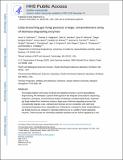| dc.contributor.author | Solomon, Kevin V. | |
| dc.contributor.author | Haitjema, Charles H. | |
| dc.contributor.author | Henske, John K. | |
| dc.contributor.author | Gilmore, Sean P. | |
| dc.contributor.author | Lipzen, Anna | |
| dc.contributor.author | Brewer, Heather M. | |
| dc.contributor.author | Purvine, Samuel O. | |
| dc.contributor.author | Wright, Aaron T. | |
| dc.contributor.author | Theodorou, Michael K. | |
| dc.contributor.author | Grigoriev, Igor V. | |
| dc.contributor.author | Thompson, Dawn A. | |
| dc.contributor.author | O'Malley, Michelle A. | |
| dc.contributor.author | Borges-Rivera, Diego Ramon | |
| dc.contributor.author | Regev, Aviv | |
| dc.date.accessioned | 2017-03-07T18:42:17Z | |
| dc.date.available | 2017-03-07T18:42:17Z | |
| dc.date.issued | 2016-03 | |
| dc.identifier.issn | 0036-8075 | |
| dc.identifier.issn | 1095-9203 | |
| dc.identifier.uri | http://hdl.handle.net/1721.1/107222 | |
| dc.description | available in PMC 2016 November 07 | en_US |
| dc.description.abstract | The fungal kingdom is the source of almost all industrial enzymes in use for lignocellulose bioprocessing. We developed a systems-level approach that integrates transcriptomic sequencing, proteomics, phenotype, and biochemical studies of relatively unexplored basal fungi. Anaerobic gut fungi isolated from herbivores produce a large array of biomass-degrading enzymes that synergistically degrade crude, untreated plant biomass and are competitive with optimized commercial preparations from Aspergillus and Trichoderma. Compared to these model platforms, gut fungal enzymes are unbiased in substrate preference due to a wealth of xylan-degrading enzymes. These enzymes are universally catabolite-repressed and are further regulated by a rich landscape of noncoding regulatory RNAs. Additionally, we identified several promising sequence-divergent enzyme candidates for lignocellulosic bioprocessing. | en_US |
| dc.description.sponsorship | United States. Dept. of Energy. Office of Science (Biological and Environmental Research (BER) program) | en_US |
| dc.description.sponsorship | United States. Department of Energy (DOE Grant DE-SC0010352) | en_US |
| dc.description.sponsorship | United States. Department of Agriculture (Award 2011-67017-20459) | en_US |
| dc.description.sponsorship | Institute for Collaborative Biotechnologies (grant W911NF-09-0001) | en_US |
| dc.language.iso | en_US | |
| dc.publisher | American Association for the Advancement of Science (AAAS) | en_US |
| dc.relation.isversionof | http://dx.doi.org/10.1126/science.aad1431 | en_US |
| dc.rights | Creative Commons Attribution-Noncommercial-Share Alike | en_US |
| dc.rights.uri | http://creativecommons.org/licenses/by-nc-sa/4.0/ | en_US |
| dc.source | PMC | en_US |
| dc.title | Early-branching gut fungi possess a large, comprehensive array of biomass-degrading enzymes | en_US |
| dc.type | Article | en_US |
| dc.identifier.citation | Solomon, K. V., C. H. Haitjema, J. K. Henske, S. P. Gilmore, D. Borges-Rivera, A. Lipzen, H. M. Brewer, et al. “Early-Branching Gut Fungi Possess a Large, Comprehensive Array of Biomass-Degrading Enzymes.” Science 351, no. 6278 (February 18, 2016): 1192–1195. | en_US |
| dc.contributor.department | Massachusetts Institute of Technology. Department of Biology | en_US |
| dc.contributor.mitauthor | Borges-Rivera, Diego Ramon | |
| dc.contributor.mitauthor | Regev, Aviv | |
| dc.relation.journal | Science | en_US |
| dc.eprint.version | Author's final manuscript | en_US |
| dc.type.uri | http://purl.org/eprint/type/JournalArticle | en_US |
| eprint.status | http://purl.org/eprint/status/PeerReviewed | en_US |
| dspace.orderedauthors | Solomon, Kevin V.; Haitjema, Charles H.; Henske, John K.; Gilmore, Sean P.; Borges-Rivera, Diego; Lipzen, Anna; Brewer, Heather M.; Purvine, Samuel O.; Wright, Aaron T.; Theodorou, Michael K.; Grigoriev, Igor V.; Regev, Aviv; Thompson, Dawn A.; O'Malley, Michelle A. | en_US |
| dspace.embargo.terms | N | en_US |
| dc.identifier.orcid | https://orcid.org/0000-0002-1650-2289 | |
| dc.identifier.orcid | https://orcid.org/0000-0001-8567-2049 | |
| mit.license | OPEN_ACCESS_POLICY | en_US |
